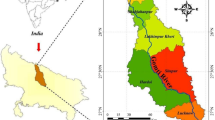Abstract
The main purpose of this study is to classify/characterize the landforms within a river basin using complex spatial information and GIS application to recognize and extort geomorphologic properties of Digital Elevation model with 30 m resolution. The landform classification is based on the Topographic position index (TPI) of the area under study—the Ithikkara and Kallada river basins, Southern Western Ghats, Kerala, India. The TPI generated was used for classifying the landscape to slope position index and landform classes. The slope position classes identified are Ridges/Hilltop/Canyon edge, Upper slope, Mid slope, Flat, Lower slope and Valley. The Landform classes includes (1) Canyons, deeply incised streams, (2) Midslope drainages, shallow valleys, (3) Upland drainages, headwaters, (4) U-shaped valleys, (5) Plains, (6) Open slopes, (7) Upper slopes, mesas, (8) Local ridges/hills in valleys, (9) Midslope ridges, small hills in plains and (10) Mountain tops, high ridges. 50.23% of the study area belongs to the slope position class—Ridges/Hilltop/Canyon edge. 30% of the study area is occupied by the landform class Canyons and deeply incised streams followed by Mountain tops and high ridges which covers 28.16%. The U shaped valleys represent 12.32% of the study area. The validation of landform classes is done by overlaying the stream network of the basin is into the landform classes, which is perfectly overlapping with the U shaped valleys of the landform classes. The classification of landform from the study can be used in applications related to precision agriculture, land use alteration studies where the most dominant factor is landform.








Similar content being viewed by others
References
Dickson BG, Jenness JS, Beier P (2005) Influence of vegetation, topography, and roads on cougar movement in southern California. J Wildl Mgmt 69:264–276
Evans S (1990) General Geomorphometry. In: Goudie AS, Anderson M, Burt T, Lewin J, Richards K, Whalley B, Worsley P (eds) Geomorphological techniques, 2nd edn. Unwin Hyman, London, pp 44–56
Fels JE, Zobel R (1995) Landscape position and classified landtype mapping for statewide DRASTIC mapping project. North Carolina State University Technical Report
Florinsky V, Eilers RG, Manning G, Fuller LG (2002) Prediction of soil properties by digital terrain modelling. Environ Model Softw 17: 295–311
Gerçek D (2010) Object-based classification of landforms based on their local geometry and geomorphometric context. PhD Diss., University of Middle East Technical
Ghosh T, Kanchan R (2016) Aquifer vulnerability assessment in the Bengal alluvial tract, India, using GIS based DRASTIC model. Model Earth Syst Environ 2:153. https://doi.org/10.1007/s40808-016-0208-5
GSI (2005) Geology and mineral resources of the states of India, part IX—Kerala (pp 21–22). Geological survey of India, miscellaneous publication no. 30
Hema CN, Padmalal D, Ammini J (2015) Hydrochemical assessment of tropical springs—a case study from SW India. Environ Monit 187:48
Jayadev SK (2012) The status of wetland in Kollam district. Phd Thesis University of Kerala
Jenness J (2005) Topographic Position Index (tpi_jen.avx) extension for ArcView 3.x, v. 1.3a. Jenness Enterprises. http://www.jennessent.com/arcview/tpi.htm
Jothibasu A, Anbazhagan S (2016) Modeling groundwater probability index in Ponnaiyar River basin of South India using analytic hierarchy process. https://doi.org/10.1007/s40808-016-0174-y
Marzieh Mokarram M, Roshan G, Negahban S (2015) Landform classification using topography position index (case study: salt dome of Korsia-Darab plain, Iran). Model Earth Syst Environ.1:40. https://doi.org/10.1007/s40808-015-0055-9
Michael EA, Samanta S (2016) Landslide vulnerability mapping (LVM) using weighted linear combination (WLC) model through remote sensing and GIS techniques. Model Earth Syst Environ. https://doi.org/10.1007/s40808-016-0141-7
Mokarram M, Sathyamoorthy D (2015) Modeling the relationship between elevation, aspect and spatial distribution of vegetation in the Darab Mountain, Iran using remote sensing data. Model Earth Syst Environ 1:30. https://doi.org/10.1007/s40808-015-0038-x
Pakoksung K, Takagi M (2015) Remote sensing data application for ood modeling. J Appl Surv Technol 26:115–122
Pakoksung K, Takagi M (2016) Digital elevation models on accuracy validation and bias correction in vertical Model. Earth Syst Environ 2:11. https://doi.org/10.1007/s40808-015-0069-3
Pfiffner AKühni OA (2001) The relief of the Swiss Alps and adjacent areas and its relation to lithology and structure—topographic analysis from 250-M DEM. Geomorphology 41:285–307. 2001
Pike RJ (1999) A bibliography of geomorphometry, the quantitative representation of topography supplement 3 (open-file report 99–140), US. Geological Survey
Rasemann S, Schmidt J, Schrott L, Dikau R (2004) Geomorphometry in mountain terrain. In: Bishop MP, Shroder JF (eds) GIS and mountain geomorphology. Springer, Berlin, pp 101–145
Salvacion A,R (2016) Terrain characterization of small island using publicly available data and open- source software: a case study of Marinduque, Philippines. Model. Earth Syst Environ 2:31. https://doi.org/10.1007/s40808-016-0085-y
Tagil S, Jenness J (2008)) GIS-Based automated landform classification and topographic, landcover and geologic attributes of landforms around the Yazoren Polje, Turkey. Journal of Applied Sciences 8:910–921
Verhagen J, Verburg P, Sybesma M, Bouma J (1995) Terrain modelling as a basis for optimal agroecological land management using dynamic simulation. In: Robert PC (ed) Site-specific management for agricultural systems. ASA, CSSA, and SSSA, Madison, pp 229–250
Vinod PG (2017) Development of topographic position index based on Jenness algorithm for precision agriculture at Kerala, India. Spat Inf Res 25:381–388. https://doi.org/10.1007/s41324-017-0104-8
Weiss (2001) Topographic positions and landforms analysis (conference Poster). In: ESRI International user conference. San Diego, CA, pp. 9–13
Wilson JP (2012) Digital terrain modeling. In: Geospatial Technol Geomorphol Mapp Proc 41st Annu Binghamt Geomorphol Symp 137:107–121
Acknowledgements
The authors thank the Dr. D. Padmalal, Scientist F and Head, Hydrological Processes, National Centre for Earth Science Studies, Thiruvananthapuram for the encouragement and support. Thanks are also due to Department of School of Environment Studies, Cochin University of Science and Technology (CUSAT), for the support.
Author information
Authors and Affiliations
Corresponding author
Ethics declarations
Conflict of interest
The authors declare that they have no conflict of interest.
Rights and permissions
About this article
Cite this article
Nair, H.C., Joseph, A. & Padmakumari Gopinathan, V. GIS Based landform classification using digital elevation model: a case study from two river basins of Southern Western Ghats, Kerala, India. Model. Earth Syst. Environ. 4, 1355–1363 (2018). https://doi.org/10.1007/s40808-018-0490-5
Received:
Accepted:
Published:
Issue Date:
DOI: https://doi.org/10.1007/s40808-018-0490-5




